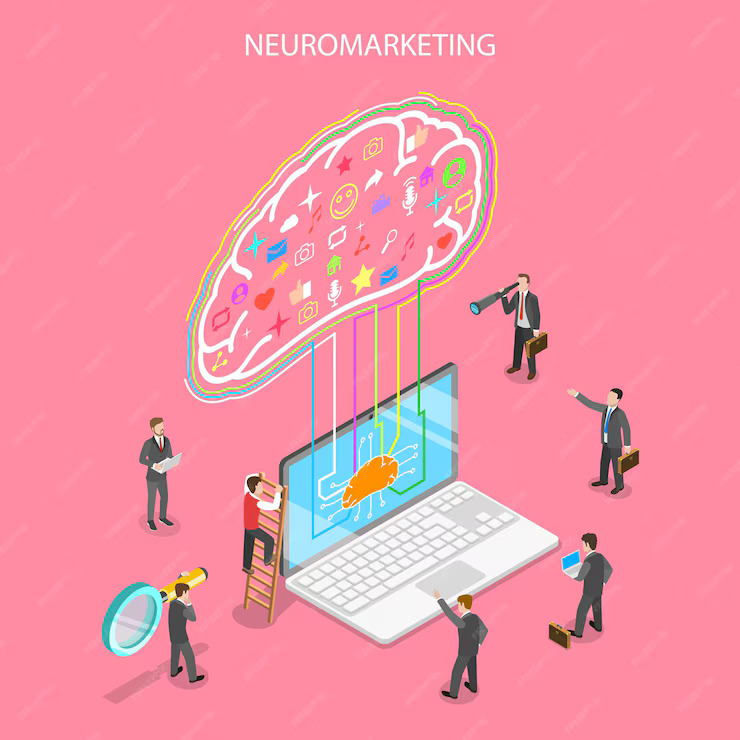16 Aug 2024 |
By - Sudha Mariappan

Emotions play a huge role in marketing.
As a consumer, what we see, feel and perceive is what we use in the end. Whether it be a simple cloth we buy, to a whole house, our emotions rule our decisions.
When we were younger, the brands that were exhibited to us are the result of the nostalgia we face today when we see them again. For example, it’s a universal experience for 2000s kids to use Amul milk.
Remember this Ad? We all have witnessed the “Amul Doodh Peeta Hai India” Ad.

Advert Gallery
So, how do these nostalgia induced advertisements work?
This connection which we feel as a consumer is a known technique used by the marketers named, “Neuromarketing”. This technique is basically used to make their brands stay in your head all the time.
It also allows them to make better strategic decisions, and get to know about customer preferences easily.
With traditional marketing, we could only make so many decisions because of its major inability to provide specific demographic details and narrow down your target audience.
But with neuromarketing, marketers can set aside demographic details and instead focus on different brain stimuli to obtain a better understanding of the consumer, through which they can better market the product.
Neuromarketing is the spectrum of marketing where it involves using consumer’s brain chemistry to analyze their product behaviours. It evaluates the consumer's mind through advertising, your brand’s packaging, your brand’s colour theory and content.
With many marketing techniques, neuromarketing becomes essential because it applies the knowledge gained from neuroscience and the cognitive scientific research, which makes marketing more effective.
This scientific research involves scanning consumers' brains by eye tracking and facial coding. Usually, marketers' only concern involves tracking consumers’ non conscious behaviour, but consumers’ can’t or sometimes won’t describe their preferences or decision making process. For that, measuring tools such as fMRI and EEG are used. Images from those tools helped marketers to accurately predict the non-conscious decision making of the consumers.
Effective marketing involves customization of products, to make consumers satisfied. One of the many examples include mass customization where the consumers have full right to choose from the range of options provided.
A brand may need a different version of their product to be made more appealing to their consumers. For example, Banks create Internet Banking for the convenience of the user. Personalized music apps which display what exactly the user wants goes to show that it is the preference of the consumer.
Why is Neuromarketing used?
It may seem a little unsettling to know marketers use this method, technically, to slightly manipulate you to use their products. But many companies are already implementing neuromarketing marketing strategies.
People might be wary of neuromarketing as it may be a little intrusive and confusing as well. Marketers on the other hand are living an easier life by neuroscience or neuromarketing. Before this, marketers had no choice but to use traditional marketing methods such as taking manual interviews, and run focus groups to learn about their consumer’s preferences.
The limited knowledge provided by traditional marketing frustrated most marketers, which led to neuromarketing.
The reason why marketers use neuromarketing is:
- With the attention span decreasing day by day, it is now more than essential that marketers use neuromarketing.
- It helps marketers understand their target audience better and segregate them to their customized products.
- By using neuroscience, marketers can actually decode non-conscious decisions which may not be visible through the naked eye.
- Gain competitive advantage by having satisfied consumers through proper services.
- Truly resonate with what the consumers feel about the product.
- Marketers can use this to create more unique and new strategies for the improvement of their brand.
- They can enhance their advertising campaign and boost sales.
- Is neuroscience used in neuromarketing?

Neuroscience plays a very pivotal role in neuromarketing. Using neuroscience, marketers can have a deeper understanding of consumers by merging it with marketing strategy. They get to know about the depths of how the brain reacts to different stimuli and through that create more effective campaigns as discussed above.
But what tools did marketers use to understand cognitive functions?
Neuroscience is basically the study of the nervous system, with a particular focus on the brain and its impact on behavior and cognitive functions. It seeks to find out how people think, feel, and make decisions.
Neuromarketing utilizes the equipment and techniques of neuroscience to record the reactions of consumers when exposed to various marketing stimuli such as ads, products, and brand messages. It helps you understand what exactly may cause customers to feel certain emotions and what drives their purchasing decisions.
For this, two main tools are used:
Functional Magnetic Resonance Imaging (fMRI): Blood flow in the brain is measured, and it shows what part of the brain is activated upon viewing a certain product or its ad. Suppose you wanted to determine whether an ad evokes positive emotions, FMRI can show which parts of the brain light up as a result of an ad.
Electroencephalography (EEG): EEG measures electrical activity in the brain. In neuromarketing, it finds broad applications to study how consumers emotionally experience a product and to what degree of attention. With the attention span deteriorating day by day, this tool helps you to know whether your viewer is thoroughly engaged, or their attention is wavering.
Not only that, through tools such as eye tracking technology and monitoring heart-rate, you can clearly tell what the consumers are thinking even though their face might tell a different story.
Eye Tracking: With eye-tracking technology, you actually see where a person is looking and for how long. You understand precisely what catches their attention first, where they linger, and what they ignore. This will be more helpful in designing packaging or website layouts.

Heart Rate: Heart rate measures a consumer's emotional state. Anytime a person becomes excited, fearful, or startled, the rates change. You will be able to take that information and measure the degree of emotional involvement your advertising has generated.
Neuroscience tools help you in creating marketing contents with an emotional touch. It helps to understand which element-colors, sounds, and visuals-can trigger activity in the brain associated with emotional responses and lead to deeper connections with a brand.
These tools have insights that will improve the design of products and packaging and will help to understand consumer preferences through their reactions to different designs. You can start customizing packaging and features of your product based on what really captures the attention of your target audience, which is essentially more sales and brand loyalty.
Neuroscience can help with advertisement campaign optimizations, where multiple versions of your ads are put to test against each other by measuring what kind of reaction each gets. The data help you in refining and creating an optimized version of your advertising for maximum impact, wherein catching the attention and interest of prospective customers will be achieved.
By knowing the neural processes involved in decision making, you will be able to create customer experiences that align with the ways of the brain. That may mean simplifying the process of buying and reducing cognitive load, or using colors and font types which are more appealing to the brain.
In simple words, neuroscience will help you in segmenting the audiences by their subconscious preferences and behavior patterns. Then you can personalize your brands according to what their eyes see, and what their hands feel.
Neuromarketing will also let you measure the effectiveness of your campaigns in real time. Instead of solely depending on traditional metrics like clicks and impressions, you will be able to make use of neuroscience tools that assess how well your campaigns resonate with your audience on deeper and more emotional levels.
Read Also: Welcome to the New Era of Social Proof for High Engagement, Where It's More Than Just Customer Testimonials.
Popular brands that use neuromarketing:
Neuromarketing has established itself as a potent tool among all popular brands to trace their customers at a deeper subconscious level. All brands will actually be able to make marketing strategies that ring better among their target audience by leveraging how the brain reacts to various stimuli.
Below, let's discuss several well-known brands that use neuromarketing techniques to build stronger connections with people, evoke their emotions, and drive sales.
Not to mention the sweet feeling of nostalgia.
1. Coca-Cola:
Coca-Cola is one of those brands that applies neuromarketing to connect with their customers on an emotional level. For many years, Coca-Cola has become synonymous with heartwarming advertisements that often focus on themes of happiness, togetherness, and nostalgia.
Outing with your friends? Family gatherings? or a graduation party? No matter what corner of the world we live in, we hear, we talk and we also have used the product.
Probably the most famous neuromarketing strategies involve the usage of the color red by the brand. Several studies have already proved that this color evokes excitement, passion, and urgency. The brand also developed iconic slogans like "Open Happiness," targeting the brain's reward system to provoke a positive emotional response.
Also, Coca-Cola uses nostalgia through the re-release of classic ads and campaigns. Probably the most common is the reuse of its classic Christmas ads featuring Santa Claus. It evokes memories of childhood and all the joy associated with holidays, thus helping build strong emotional bonds with the brand.
2. Apple:
The next brand, that has absolutely killed the art of neuromarketing is Apple. The company always builds huge earnings and exclusivity among customers. By using sleek and minimalist designs and advertisements with emotional overtones, Apple is able to create an appeal to the consumer with regard to status and identity.
Apple designs the release events in their own way, filling the users with excitement and anticipation. Building suspense for a new product launch triggers the brain chemical associated with pleasure and reward: dopamine. And this anticipation turns into long queues and high sales volumes without even the consumers getting to try the new product.
Apple uses storytelling quite effectively, too. Most of the ad campaigns or promotional content it releases show how the products can alter life, solve problems, or boost creativity. This again appeals to aspirations and emotions.
3. Nike:
For many people, Nike represents bravery and achievement. The "Just Do It" campaign is not just a catchphrase; it appeals to consumers' desire to overcome obstacles and reach great heights.

Youtube
Nike attached emotionally to the audience through the use of endorsements from athletes and inspirational stories. As a result, the brain often mirrors the perceived feelings of people, a concept known as neural mirroring. Since Nike normally features athletes who overcome some deeply challenging obstacles, it evokes feelings in its viewers, creating an attachment to the brand.
The brand also tries to include the use of neuroscience in how its product is designed by using colors and shapes that have proven to trigger positive responses in the brain. For example, bold colors such as red and orange are said to trigger excitement and motivation, which aligns with how dynamic and active the brand wants people to perceive them.
4. Google:
Google is the master of neuroscience to make the user experience easy. We need Google even for a simple query. They are focused on reducing cognitive or conscious intellectual activity load, which uses a lot of mental effort to use any product or service.
Google provides interfaces that are clean, simple, and easy to navigate; they make sure users get what they want as quickly as possible without them feeling overwhelmed.
Google also utilizes neuromarketing through their search results and ads. By analyzing user behavior and search history, Google is in a position to deliver to the user content most likely to seize the users' attention.
In this form of personalization, Google triggers the brain's reward system-which is more greatly satisfied once it receives content it has been interested in.
5. McDonald's:

McDonald's uses neuromarketing mainly through color theory, especially through its colors, sounds, and sensation. There is nothing coincidental in the usage of red and yellow hues in this company's logo and packaging.
When you look at these colors, you'll sense a feeling of appetite growing or a feeling of urgency, which is the ultimate goal of McDonalds.
McDonald's also pays attention to multisensory stimulation. The aroma of fried French fries, the sizzling sound of a burger, and packets of food in bright colors activate the brain system. This sensory stimuli releases dopamine, making your McDonald's experience more pleasurable and memorable.
It's also common for McDonald's to run programs of nostalgic marketing and to carry advertisements that create certain types of urgency, such as popular character comebacks, using the Hamburglar and Ronald McDonald characters.
They also run promotions on their limited-time offers, like bringing back some of their old products, which brings nostalgia into the consumers.
6. Cadbury:
Cadbury is another brand that has utilized neuromarketing in an attempt to evoke emotions and create meaningful connections with its customers. Probably one of the most famous campaigns is "Gorilla".
The campaign featured a gorilla drumming to the song of Phil Collins's "In the Air Tonight." This ad was funny and different from previous ones that directly featured the product. It concentrated on eliciting an emotional response from its audience.
The ad ran and was hugely successful tapping into surprise, humor, and joy-motivators that stimulate the brain's reward center. Cadbury also often adds themes of sharing and togetherness in its advertising surefire way to appeal to emotions related to love and happiness.
Their famous hashtags such as #HowFarWillYouGoForLove and #MyBirthday song indicates they really care for the consumers, making them more satisfied.
Cadbury's campaigns bank on the power of nostalgia by reintroducing classic packaging or flavors. Such a strategy helps consumers revisit happy moments of their past attached to the brand, hence increasing the emotional affinity they will feel with the brand. For example, Cadbury tried to add a heart in the middle of their purple for couples during valentine's season, which interested everyone!
7. Spotify:
Being a music streaming app, Spotify relies on neuromarketing features. Especially through their personalization power and prediction about users' taste, they are versatile in creating an impact into users' brains.

Their campaigns, such as "Discover Weekly" playlists, along with personalized recommendations, are fitted in a way to provoke the release of dopamine.
Spotify's song suggestions, based on users' listening history, appeal greatly to their brain's needs for familiarity.
Visual cues like album covers and color schemes also mean something on this platform. When you see your favorite artist having colorful album covers and attracting lyrics, it usually elicits positive emotional responses and really heightens the experience.
Conclusion: The main ingredient in creating neuromarketing is heightening the sense of nostalgia and dopamine. With these two main brain stimuli, brands can conquer their campaigns successfully.
Your brand should deeply resonate with the consumers. Because in a world where consumers are bombarded with a huge pile of marketing messages every day, you need to tap into the consumer’s brain’s subconscious responses and create emotional connections.
Understanding your consumers’ brain responses like this won’t be an invasion of their privacy, instead, as a brand, you’ll be able to understand your consumers better.
While there is so much noise going around, don’t let your brand get lost in it. If you’re in need of ideas for neuromarketing that drive engagement and create campaigns that truly resonate with your audience, connect with us at info@ontogendigital.com.
If you’re interested in more content like this, subscribe to us for more blogs.
KEY TAKEAWAYS:
- Neuromarketing uses brain science to tap into consumer emotions, creating lasting brand connections.
- Tools like fMRI, EEG, and eye tracking help marketers understand subconscious consumer behavior and preferences.
- Brands like Coca-Cola, Apple, and Nike use neuromarketing techniques to evoke nostalgia, excitement, and brand loyalty.
- Personalization and emotional storytelling are key elements in neuromarketing strategies to enhance consumer engagement.
- Neuromarketing provides a competitive edge by decoding non-conscious decisions, optimizing campaigns, and boosting sales.